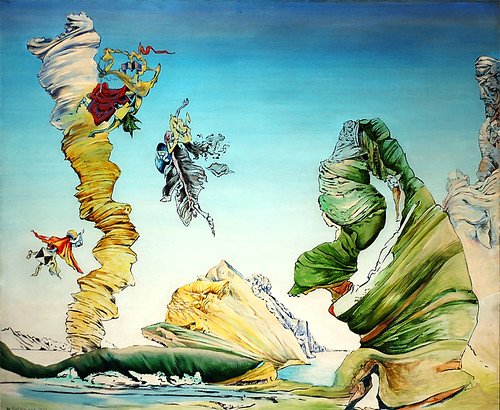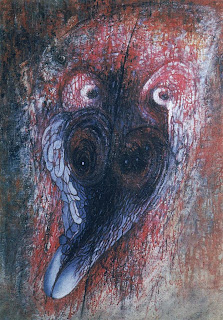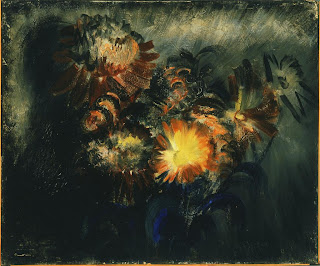Thursday, October 30, 2008
Abstract Painting Reflection
Prior to the critique, I was pleased with the state of my painting in that the resulting image was what I was going for. However after talking with the critique I was slightly disappointed by how easily readable it was. I struggled with moving away from recognizable images while painting, which was evident by my final. For my next attempt at abstract painting, I hope to work from less literal ideas and I feel that will make my painting more "successful" as abstraction.
Wednesday, October 29, 2008
Painting Journal
My painting is an abstraction of the Nike corporation. To start, I thought about how much I hate corporations. I don't use the word "hate" very often, except for the casual, "Aw I hate mosquitoes", or "Man, I really hate 'High School Musical' and everything associated with it". That sort of thing. Back to corporations, I have such strong negative feelings towards corporations, especially ones as pervasive as Nike and friends, because they force themselves into our lives. We unknowingly give so much of ourselves to corporations, even if we do not buy their products directly.
Furthermore, I find it incredibly disheartening that 99% of what I own is mass-produced. Nothing is unique. The shirt that I'm wearing, the shoes on my feet (which are Nikes), even my blessed, blessed paint brushes, all are mass produced. Things one considers to be their little individuality-identifiers are not all that individualizing after all. Ahh, such is life. The only true belongings are ones that are born of your own creation.
For the painting, I wanted to boil down what I think corporations like Nike do to our society. They consume. They entice. They control. And yet their atrocities go unnoticed. For me, this painting is nothing more than an abstraction of these aspects.
Post-critique response:
I liked the way the critique went. I was happy that the subject was not totally clear, because I was trying to break completely from any representation. Glad to hear that people got a sense of production and industrial qualities. I think that the whole 'not sharing any information until later' structure to the critique complemented the abstract assignment well because people reacted to the paintings without any priming to the subject of the work.
Tuesday, October 28, 2008
Zach Coneybeer- Painting Journal
Approximately three years ago, my sister left my family and chose to elope with her boyfriend, a man almost twice her age, against my parents will. The way in which she decided to leave and the actions she has taken since then have been emotionally hard on my parents and me. On a personal level, it has been extremely hard for me as a student away from home to deal with the emotional issues associated with her absence; because it is not that she’s gone, it’s that she’s gone a refuses to communicate with me or my family. Since her initial departure three years ago, I have only communicated with her a hand-full of times, each time being by email or by telephone conversations. The loss of an immediate family member has stimulated me to question my faith, my role in a family and my identity as a human being. In addition, it has also been a large influence on my work as an undergraduate studio art major. Although the actual subject of this topic has only appeared once in my
For my abstract painting, I intend to respond to the memories of my sister before and after her absence. My intentions are to meditate on her and paint intuitively from the memories. Due the spontaneity of memory I can predict that my painting will also be influenced by my mother and father due to many memories of my sister involving my family as a whole. As a result of recalling memory, I also will respond to the various emotions I experience when thinking about my sister.
I can say firmly that I do not have a clear prediction of the final outcome of the painting due to the nature of recollection where I will be in the act of memory recollection while simultaneously painting; however, I can predict that the decisions I make will be a combination of conscious and subconscious intuitive marks. The primary focus of the painting, or the subject itself, will be my sister. Any other aspect of subject matter such as my parents, me or emotions I associate with my sister will be by-products of memory recollection. I also intend to base the painting specifically on memory during the actual process of painting and will not use any outsides sources, such as photographs or mementos. I feel that any physical object that relates to my sister will only hinder my ability to tap into my conscious and subconscious memory of my sister. The final visual result will be closely linked with abstract expressionism where I am living through the memory of my sister using the paint as a tool for translating my memories into a physical art object.
Session 1
As a foundation to the final painting, I decided to layout the composition of the subject matter by painting memories from a stream of thought. As a meditative exercise, prior to painting I wrote down as many thoughts, both positive and negative, of my sister that I could recall. After filling about a half page of memories, I began reading the recollections as a whole; as if the memories were a paragraph. This process allowed me to focus my concentration of my sister as a whole and not as a juxtaposition of memories. I then made mental visualizations of each memory and, using the same process of writing memories, I began painting the mental visualizations as a stream of thought. I allowed my body to physically recall my sister giving freedom to my body to make marks naturally and intuitively without making marks that were distinguishable. If I painted distinguishable elements or objects, this would allow my audience to make assumptions that I did not intend for. (i.e. painting my sister as a little girl would stimulate discussion of my sister, my childhood with my sister, my reflection of growing up etc.) I want the final product to speak for itself and not force dialogue but invite it. I continued by painting one thin layer of paint as an under layer and reduced any identifiable shapes into the most basic forms possible. After the under-painting was finished, I ended my session.
Session 2
Unlike the first session where I focused on the memories, I began by reflecting on the under-painting and tried to make sense of it. I began to try to identify the memories that I had painted and what emotions I associated with each memory. Further more, I began to think what color do I associate with each specific memory, and even further, what mark or gesture describes that emotion. The composition of each memory, the color it takes on and the marks made to visualize the memory had to , in my mind, reflect and capture the moment of that memory. For example, one memory of my sister was when wqe were around 10 or so, we went for a hiking trip with my parents. It was fall and I remember the millions of dried leaves on the ground in the forest where we were hiking and the sounds they made when my sister and I jumped and played in them. To visualize this specific memory, I choose to use a warm brown and short, deliberate strokes to capture the sound and act of crunching leaves. I approached each memory in this manner and worked on the top third of the painting. I then ended the session to reflect on the marks I had made so that I could plan my next session. I took a photograph and went home.
Session 3
After careful thought and meditation, I approached the painting again through association and painted the entire canvas. In this session, I was focused on how I can begin to connect the memories together without sacrificing composition. I began then to work through each memory and began to draw formal compositional connections with each memory. I did this by analyzing the marks I made, texture relationships and color relationships. Due to class room activity, (music, time of day, etc.) I decided not to force the work and ended the session earlier then expected. This was beneficial to me because I didn’t want to stray from my subject. I took a photograph and went home.
Session 4
In this session, I began by associating other colors and textures with memories of the under-painting that I haven’t addressed by this point. I began by adding a brilliant green and more white, alternated my marks between loose and controlled, and allowed my textures to become intuitive extensions of my gestures. I began pulling out the composition and memories together and decided to step back and examine and reflect on the work. I came to the conclusion that the work reflected only positive memories of my sister, and thereby only the memories before she left. So at this point, I felt that it was necessary to dive into the negative side of my subject: the absence of my sister. For some reason, I though of the absence of color: black. Almost like a void, the painting at the time lacked my personal loss of emotions for my sister. That is, the loss of her physical support and her emotional support as a biological family member. In addition, it was this loss that tainted my fondest memories of my sister. The hatred I feel conflicting with the love and devotion for Meagan. It was then I realized I had to visualize this by adding the crude, thick, gloopy black to the painting. My strokes were violent, as if I was attacking my memories, cursing my sister and her actions. It brought back feelings of not only hate and disgust, but also confusion and anguish of not knowing the reasoning for her leaving. I also began to hate myself for not having the answer. The black became an insect, invading the colors and textures; separating them and with them the memories and tainting them with the recent visions of my sister. It became a conflict of love and hate, devotion and neglect, and being with and without. But standing back and examining, something seems odd now. I don’t really know why, but it’s not representing fully how I feel. So I took a photograph, ended the session and went home to reflect.
Session 5
I didn’t know what was off at first, so I began to meditate on my emotions in the present. Like the current painting before me, my thoughts in the present are conflicting, as are my memories. I cannot change anything about my current status with my sister, nor can I change any of the memories. They are in constant conflict where I remember this perfect loving person and now I only remember a selfish and immature individual. I keep talking about memory, but at this point I do not know if my memories are even right. I determined that through this painting I have explored my thoughts regarding my sister and identified that it is the good, the bad and the ugly that draws me to love my sister. It is the conflict of memory and the actual social conflict that still remains unsolved that I am I actually depicting. With this, I decided to create visual conflict by adding layers of color and black that contrasted each other significantly, but as a whole became as one like the memories and emotions I have for my sister. Like them, no one mark, color or texture is right or wrong, but are both. The painting developed into a conflict of all the elements in my log: memory, emotion, color, etc. But more importantly, it became a visualization of the conflict as whole of my sister and
Post-Critique
I first must say that not having to speak about the work and allowing the work to speak for itself was a relief. In addition, I believed my painting stimulated conversation and questions without me having to explain anything, which to me makes the work successful. The commentary on my painting was not too far from my intentions where the comments where almost synonymous with my subject. For example, the map-like qualities work easily as a description of how I plotted the memories on my canvas (like brain mapping). In addition, the comments regarding segmentation and fragmentation the composition also work in a similar context, where the memories are separate from another as their own entities. The closest comment was the fact that the colors and shapes were both connected and separated by the black where both elements stand alone yet work as one element. This is closely related to my memories of my sister, where I have separated the good from the bad yet they are all still memories that I can not discard. In summation, this comment is closely related to the aspect of conflict that I discuss above. Like my relationship with my sister where I possess mixed feelings of love and hate, the colors and black both work with and against each other. However, as closely linked the comments were, I can say confidently that without a title or statement, no one can look at the work and say firmly that they see a representation of conflict between the artist and his sister; but they can come to the conclusion that there is a degree of conflict in the work as whole, which to me makes the painting successful in that regard. Overall, I am happy with the outcome and am currently working on a title of the piece that does not restrict my audience and allows them to respond to the work much in the same way the class responded during the critique.
Wednesday, October 22, 2008
Tuesday, October 21, 2008
Willi Baumiester
Monday, October 20, 2008
Théodore Géricault





Théodore Géricault was born September 26, 1791 in Rouen, France. He began his artistic education under Carle Vernet before attending the Louvre where he studied works by Rembrandt and Velasquez, among others. Gericault became a pioneer in the growing Romantic Movement. Like the basic ideals of Romanticism, Gericault’s work reflected suffering and outrage expressed through the use of light and dark colors accompanied by dramatic movement (Gowing, artchive.com).
Gericault’s most famous work is The Raft of Medusa. At 193.3 x 282.3 inches, the painting depicts the wreck of the French ship Medusa and its survivors. Gericault’s masterpiece was driven by political disgust. The ship’s captain had been inexperienced but a well-connected supporter of the government’s aristocracy(www.louvre.fr). Due to an extreme shortage of lifeboats, 149 people piled onto a raft that would drift for twelve days. In the end, only fifteen survived. In those 12 days, madness and death were followed by cannibalism as a means of survival. There is no one focal point, rather the subject is generalized and the strength of humanity becomes the centerpiece (www.louvre.fr).
Gericault’s life was short, living only 32 years. However, in that short period he was able to produce some of the most influential pieces of the Romantic period. His art spoke out against the political repression that engulfed France at the time. He revealed this social imbalance through painful and dramatic expression in his painting. His subjects were often those forgotten or rejected by society. Some of his final pieces were a series of the mentally ill. These smaller works capture the normality and strangeness that coincide in the faces of the individuals.
Gericault had lengthy goals as an artist, but a tumor in his spine and a growing infection eventually led to his premature death. Gericault died dissatisfied with his life. He’d had hopes of painting entire rooms like his artistic idols. Even when asked about his Medusa he seemed disappointed. However, his artistic drive endured until his last moments as he drew and painted even on his deathbed (Eitner, 273).
Question: Gericault's works focused primarily on contemporary issues. How do you think early 19th century art compares to television today as a method for social commentary?












 alt=""id="BLOGGER_PHOTO_ID_5260244523717796050" />
alt=""id="BLOGGER_PHOTO_ID_5260244523717796050" /> alt=""id="BLOGGER_PHOTO_ID_5260244521869183634" />
alt=""id="BLOGGER_PHOTO_ID_5260244521869183634" />














 CoBrA art
CoBrA art mondrian
mondrian














